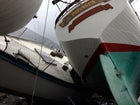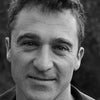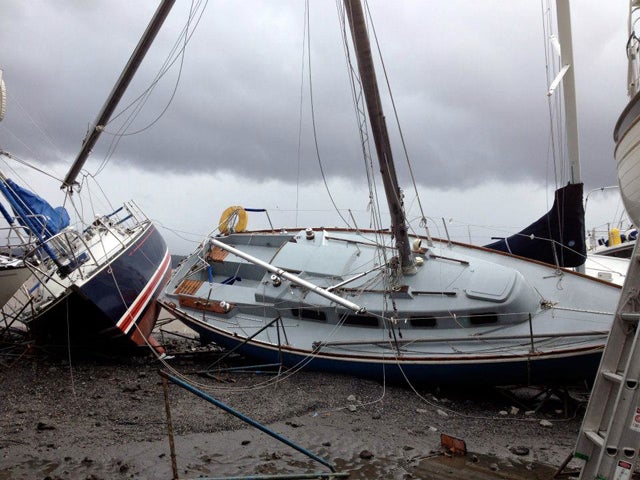On Sunday the voices on the radio all said variations of the same thing: Go where you want to stay for the next few days. Hurricane Sandy was approaching, and it was time to put in the storm windows, check the headlight batteries, and cook anything perishable. For me, the place to stay was Nyack, the town I grew up in, which sits on the west side of the Hudson River about 25 miles north of Manhattan. I’d just moved back to New York to be ���ϳԹ���’s East Coast editor, and a week later, the first winds arrived.
Julius Petersen Boat Yard
View photos from the destruction at this Nyack institution. The Julius Petersen Boat Yard.
The Julius Petersen Boat Yard.Sunday evening was spent locking in storm windows, arranging candles, buying bottled water and energy bars, and meeting the newborn son of a close friend. (Chris had wisely returned to Nyack from his waterside home in Oyster Bay, Long Island.) On Monday my father and I went out to see the early onset of the storm. The wind blew us back from the water at Memorial Park and a pier at the bottom of Burd Street, which houses a restaurant called the River Club and an eyesore of a pink apartment complex. A houseboat bobbed in the waves; we saw four sailboats lose their moorings. A dock adjacent to the apartment complex shattered, turning instantly to driftwood that piled up against the shore. It was mid afternoon, and the storm wasn’t expected to make landfall for another four hours. After that, the full moon high tide.
We went to Julius Petersen Boat Yard, a Nyack institution that an uncle of mine once managed. Rows of immaculate wooden sailboats were propped on metal stands just yards from the water, which got progressively angrier. “Those are going to go,” said my dad, stating the obvious. We took some photos and left.
The power went out around 7. A large maple took out our backyard fence shortly thereafter, one of countless trees that are down in the New York area suburbs, lying on power lines, houses, and cars. Around 8:30 I wandered back down to the river to see the high tide roll in, but I didn’t stay long: the clouds rushed east, the trees shook the power lines overhead, and when I reached the Hudson, the water was up on the baseball fields at Memorial Park. A transformer blew across the river in Tarrytown, sending an electric blue flash up to the clouds. A couple of young men had come down from a bar, which was apparently still serving booze in the dark. The two guys wanted to see for themselves whether they’d have to go to work the next day. I suggested they wouldn’t and headed back home, occasionally running under the power lines, which were interwoven with maples and oaks everywhere I looked. Around 11 the texts started pouring in: Manhattan is flooded, a crane fell, a building facade fell, there are whitecaps in the Brooklyn Battery tunnel, watch for peak winds around 2, the Indian Point Power Plant is safe. (It was briefly shut down.)
I was happy to wake this morning with nothing lost but a fence, and Mom, Dad and I went to see the water, swerving slowly around downed trees. At the River Club a small crowd of people gawked and took photos: the club had lost its pier, its foundation now naked and exposed to the tides, and a nearby houseboat had partially sunk. The pink apartment complex had lost another pier; there were cracks in the concrete on the ground floor. We went to visit some friends who live near Petersen’s Boat Yard. There, the boats had fallen like dominoes. I took some more photos, which you can see in this slideshow, and we went to the only place in town that was serving coffee: the hospital.


